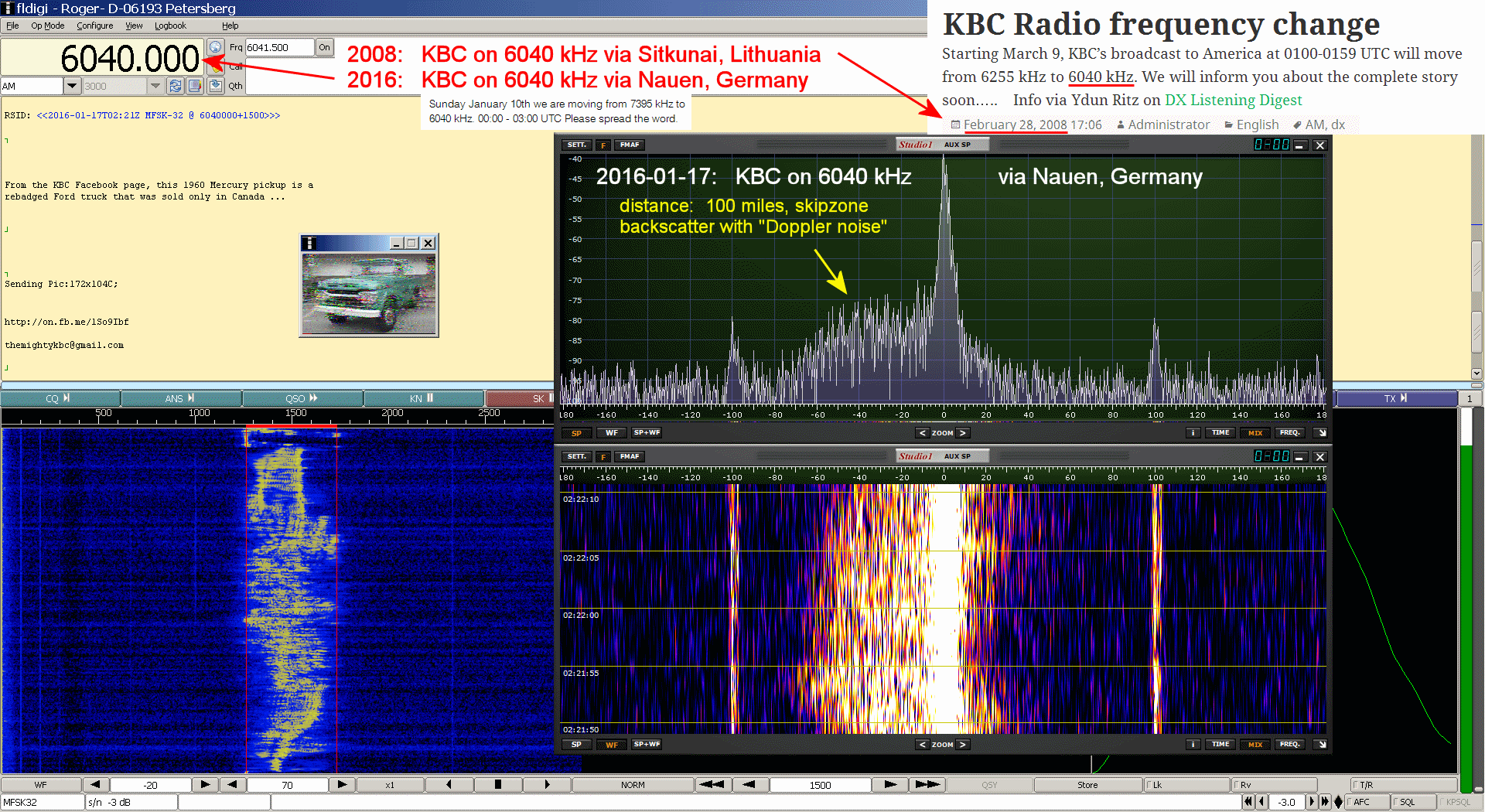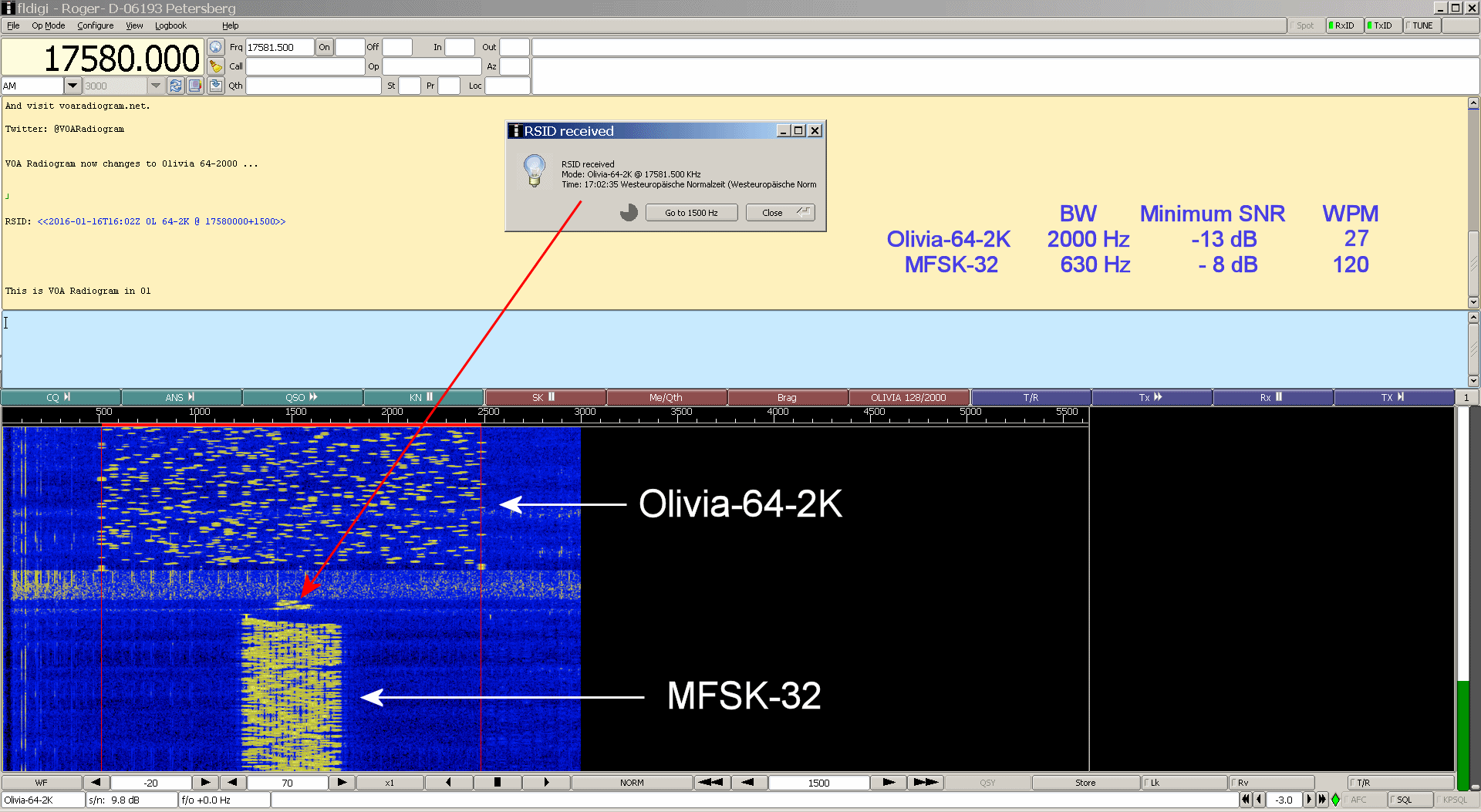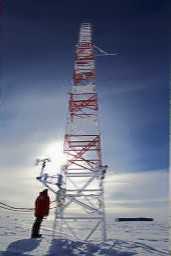www.rhci-online.net/radiogram/radiogram.htm
██╗ ██╗██████╗ ██████╗ ██████╗ █████╗ ██████╗ ██╗ ██████╗ ██████╗ ██████╗ █████╗ ███╗ ███╗
██║ ██╔╝██╔══██╗██╔════╝ ██╔══██╗██╔══██╗██╔══██╗██║██╔═══██╗██╔════╝ ██╔══██╗██╔══██╗████╗ ████║
█████╔╝ ██████╔╝██║ ██████╔╝███████║██║ ██║██║██║ ██║██║ ███╗██████╔╝███████║██╔████╔██║
██╔═██╗ ██╔══██╗██║ ██╔══██╗██╔══██║██║ ██║██║██║ ██║██║ ██║██╔══██╗██╔══██║██║╚██╔╝██║
██║ ██╗██████╔╝╚██████╗ ██║ ██║██║ ██║██████╔╝██║╚██████╔╝╚██████╔╝██║ ██║██║ ██║██║ ╚═╝ ██║
╚═╝ ╚═╝╚═════╝ ╚═════╝ ╚═╝ ╚═╝╚═╝ ╚═╝╚═════╝ ╚═╝ ╚═════╝ ╚═════╝ ╚═╝ ╚═╝╚═╝ ╚═╝╚═╝ ╚═╝
|
http://www.kbcradio.eu/

RSID: <<2016-01-17T02:21Z
MFSK-32 @
6040000+1500>>
From the KBC Facebook page, this 1960 Mercury pickup is a
rebadged Ford truck that was sold only in Canada ...
|
Sending Pic:172x104C; |
stream |
|
 |
 |
http://on.fb.me/1So9Ibf
themightykbc@gmail.com
██╗ ██╗ ██████╗ █████╗ ██████╗ █████╗ ██████╗ ██╗ ██████╗ ██████╗ ██████╗ █████╗ ███╗ ███╗
██║ ██║██╔═══██╗██╔══██╗ ██╔══██╗██╔══██╗██╔══██╗██║██╔═══██╗██╔════╝ ██╔══██╗██╔══██╗████╗ ████║
██║ ██║██║ ██║███████║ ██████╔╝███████║██║ ██║██║██║ ██║██║ ███╗██████╔╝███████║██╔████╔██║
╚██╗ ██╔╝██║ ██║██╔══██║ ██╔══██╗██╔══██║██║ ██║██║██║ ██║██║ ██║██╔══██╗██╔══██║██║╚██╔╝██║
╚████╔╝ ╚██████╔╝██║ ██║ ██║ ██║██║ ██║██████╔╝██║╚██████╔╝╚██████╔╝██║ ██║██║ ██║██║ ╚═╝ ██║
╚═══╝ ╚═════╝ ╚═╝ ╚═╝ ╚═╝ ╚═╝╚═╝ ╚═╝╚═════╝ ╚═╝ ╚═════╝ ╚═════╝ ╚═╝ ╚═╝╚═╝ ╚═╝╚═╝ ╚═╝
http://voaradiogram.net/

RSID: <<2016-01-16T16:01Z
MFSK-32
@ 17580000+1500>>
Welcome to program 146 of VOA Radiogram from the Voice of
America.
I'm Kim Andrew Elliott in Washington.
Here is the lineup for today's program, modes as noted:
1:34 MFSK32: Program preview (now)
2:51 Olivia 64-2000: Blog post from Antarctica
23:36 MFSK32: Image from Antarctica
26:32 Closing announcements*
Please send reception reports to radiogram@voanews.com.
And visit voaradiogram.net.
Twitter: @VOARadiogram
VOA Radiogram now changes to Olivia 64-2000 ...
RSID: <<2016-01-16T16:02Z
OL 64-2K @ 17580000+1500>>
This is VOA Radiogram in Olivia 64-2000.
Please send reception reports to radiogram@voanews.com.
VOA Science World Blog
Braving Brutal Cold to Tower Climb at the South Pole
Refael Klein
Posted December 22nd, 2015
Yesterday, it was minus 34 Celsius (minus 29 Fahrenheit) and
sunny.
Winds were low and visibility was perfect. The sky was a uniform
shade of blue, stretching from horizon to horizon like a taut
canvas. Walking to work, I felt like a red line running down the
middle of a Barnett Newman painting. I was an interloper in an
otherwise still scene.
Every movement I made felt accentuated and unnatural. Ice cracked
and hissed with each step of my heavy, green, insulated rubber
boots, its voice growing louder and louder until it was
deafening, and there was nothing left for me to do but stand
still and admire the desolation of the landscape.
It is rare to have South Pole days like these, especially in
early summer. The winter is never more than a few moments away.
At the flick of a wrist, the temperature can drop 30 degrees and
the wind can carry away visibility with cyclones of snow.
We make the most of the conditions whenever it is stable and
"warm", and try to dedicate part of our day to working on outside
tasks that would otherwise be too difficult or too dangerous to
accomplish.
At the Atmospheric Research Observatory (ARO), this could mean
setting up new solar radiation equipment on our rooftop, raising
electrical runs on the outside of the building, or inspecting
instrumentation on our meteorological tower.
Given the sheer beauty of the day, we decided to go climbing.
ARO's meteorological tower is 30 meters (100 feet) tall. Built
out of red-and-white, Erector-set-like pieces of steel, it is
anchored to the ground with over a dozen woven steel guy-lines.
A ladder well running through the middle switchbacks so tightly
from bottom to top that, as you ascend, you feel like an ant
walking up the threads of a screw.
Wind birds, temperature detectors, humidity probes, albedo
sensors and air intakes for instruments inside the station run
along the length of the tower. Even though the equipment is
robust, it's important to check on it regularly to ensure that
everything's working properly and not malfunctioning in a way
that impacts data quality.
I dress warmly before leaving the station, filling my pockets
with an assortment of basic tools in case I need to repair,
re-level or take down a broken instrument.
As I climb upwards, the all-metal tower sucks heat away from my
hands and feet and, by the time I'm half-way up, I'm
uncomfortably cold.
At the top of the tower, an aspirator on one of our intake lines
doesn't sound like it's spinning. I get down on my knees and roll
the right side of my windproof hat up so I can place my ear next
to the fan's plastic protective backing for a better listen.
It is hard to tell if the fan is humming along, or if it's just
my ear ringing from the brutal cold, so I take off my mittens and
wearing only thin liner gloves, begin to undo a series of thumb
screws that will allow me to remove the housing and visually
verify things. It takes me less than a minute to do so.
Everything is working fine.
I shove my numb fingers back into my mittens and rush down the
tower, hoping I can make it to the bottom before my fingers begin
to burn and swell with new blood.
http://blogs.voanews.com/science-world/2015/12/22/braving-the-elements-to-go-tower-climbing-at-the-south-pole/
VOA Radiogram now returns to MFSK32 ...
RSID: <<2016-01-16T16:23Z
MFSK-32 @ 17580000+1500>>
This is VOA Radiogram in MFSK32.
Please send reception reports to radiogram@voanews.com.
Image: Refael Klein (author of the previous blog post) at the
base of the tower in Antarctica inspecting the electrical and air
hose connections. ...
Sending Pic:171x256C;

Please send reception reports to radiogram@voanews.com.
And visit voaradiogram.net.
Twitter: @VOARadiogram
Thanks to colleagues at the Edward R. Murrow shortwave
transmitting station in North Carolina.
I'm Kim Elliott. Please join us for the next VOA Radiogram.
This is VOA, the Voice of America.
Sending Pic:316x28C;

www.rhci-online.net/radiogram/radiogram.htm




